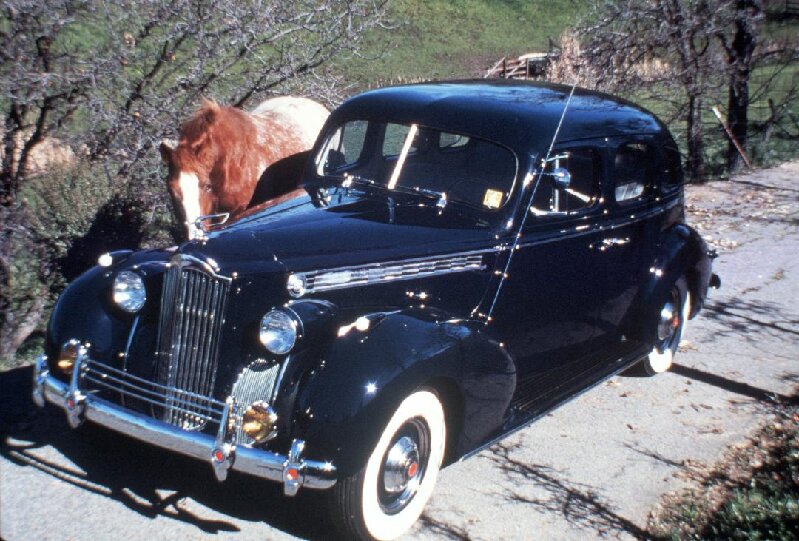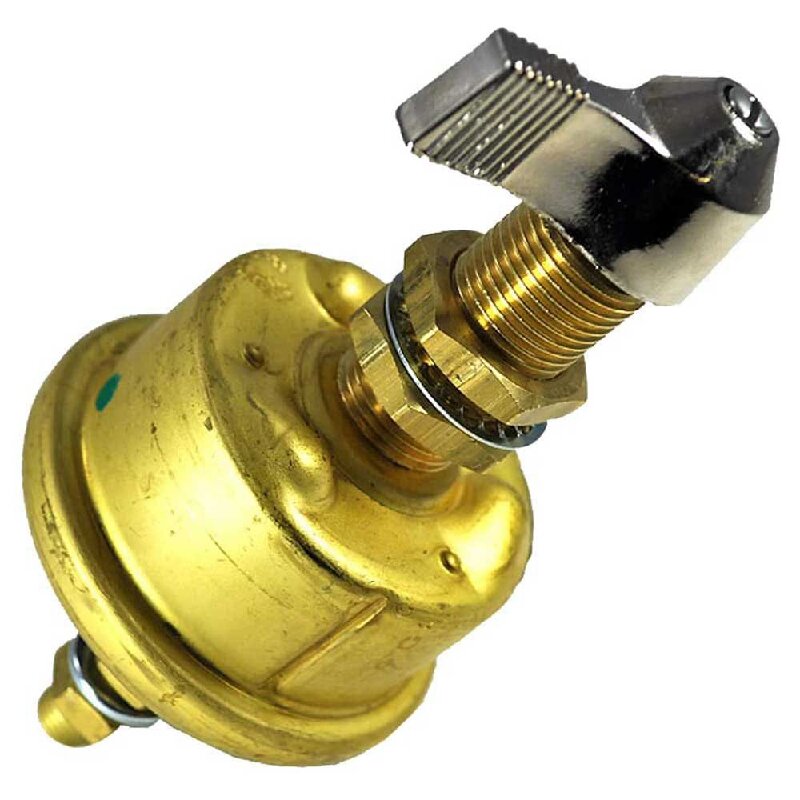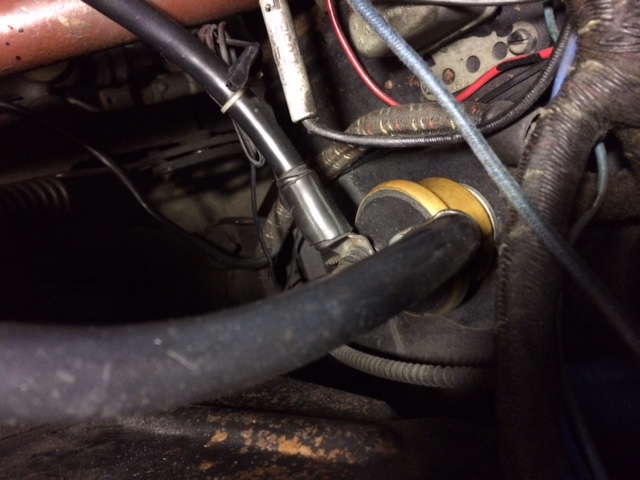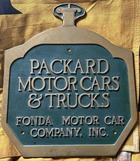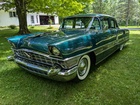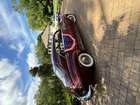|
Re: 282, 288, 327, 356
|
||||
|---|---|---|---|---|
|
Home away from home
|
First Eliminator, listen to Ross. He knows all these engines. You didn't say what year 120 you're picking up. If 1938-on, you won't have to do all the reconfiguring Bob J did on his 120" wb first generation 120, because your wheelbase will be 127".
You can't use a 288 or 327 head on a 120 because they have 3 1/2" bores, while the 257/282 120 engines 3 1/4". BTW, looking for a first year only '35 257 is ridiculous. You're going backwards to go forward. More cubic inches, all things being equal = more power, hp and torque, the latter more important because that's what gets you through the gears. If you want a good road car you can drive fast enough on the freeway to have your license revoked, add overdrive, assuming this 120 you're picking up isn't 1939-on and already has the optional overdrive. Acceleration = torque, gearing, weight. Absolute speed = horsepower, gearing, CD (coefficent of drag ratio). "Weight is the enemy." Congratulations for not destroying your new Packard by dumping in a modern V-8, turning it into another retro rod/Frankencar. So many bozos with no understanding, and no appreciation of the past, no historical perspective, just want some "cool old timey" car to wow the other dullards at a cars 'n' coffee. Knowledge is power. Listen to Ross, HH56 and the others above. If you brought your 120 into the Packard dealer's service dept. with a shot or tired engine, they routinely replaced it with a 288 from 1948-on. The 288 is an underrated, gutsy engine, and with its short stroke, will wind. Put a 327 head on it and you'll boost compression but still won't exceed 8:1 as Ross sagely reminds So your 120 will still be "authentic" and "correct," should any clipboard wielding cupcakes at some show notice, and in this day and age, all they'll see is that murky Packard green engine paint, and eight spark plugs in a row. Too many newbies want to reinvent the wheel. Packard knew what they were doing. But if you're rebuilding a 288 anyway, port and polish the manifold, lighten the flywheel. Otherwise, just follow the Packard Shop Manual. Packard knew as much about engines as Lycoming, Chrysler or GM. The 120 engine is pure Pontiac in design, but viva la difference in execution, refinement. That was Packard's way since the aughts. While Cad, Olds, Chrysler, even Studebaker about to debut or working on OHV V-8s, Packard, distracted by hefty, less hassle govt. jet engine contracts, increasingly phoned in the cars after the war. So the 288 and 327 are just large bore revisions of a 1935 engine. You do not want a 356. A 327 is nearly as powerful, more so with compression boost and/or four-barrel car, and weighs nearly 3 0 0 lbs. less than the 356 boat anchor. 356s are an expensive nightmare to rebuild correctly, and just a 282 with four more unnecessary main bearings. BTW, hydraulic valve lifters were a $25 or $50 option in the 288 and early 327s, the later editions of the latter came standard with hydraulic lifters. Since you're a rodder, i'll leave it to you whether you want dead or hydraulic lifters. But remember, Packards were about low end torque and smoothness. Losing weight and the right gearing will give you a real road car. Remember, Packard's most profitable year ever was 1929, and while they owned the fine car market through 1936, that was a minute fraction of the car biz. They were on the skids ever since, and just as they had a bell ringer in late '41, the war cut that, left them cash cows but making one automotive bad move after another ever after, a moot point because all independents were doomed. So if they couldn't get a V-8 out 'til 1 9 5 5, the same year coincidentally as Pontiac, and that V-8 had glitches and the cars shoddy, at least they still made really good flathead straight 8s. Finally, a Packard 327 and four barrel carb on either a 288 or 327 would give you more oomph. If you don't have an overdrive, get an R-11 introduced late '48. They are slightly simplified from the 1940-early '48 R-9, more plentiful, so cheaper. Jeff Adkins, Moose Motors, Penngrove (Petaluma, CA in the North Bay) has several. packardguy54@sbcglobal.net (707) 792-9985. Jeff has all the mechanical and electrical parts 1935-56. Another A-1 source is Mike Chirco, Tucson Packard (520) 336-0057, packardautoparts@gmail.com As is Mike Grimes, Merritt Packard, mike@packardparts.com, Mike Grimes, (317) 736-6233, (317) 736-6233 ext 103, ext. 103 Please tell these gents that Mike, Walnut Creek, CA '47 Super Clipper referred you. And thank another day of 100+ heat for trapping me in the office and enabling this humble seminar from half a century of Packarding (with forays into Cords, Hudsons, and dozens others).
Posted on: 7/11 14:48
|
|||
|
||||
|
Re: '37 120 Cooling Fan
|
||||
|---|---|---|---|---|
|
Home away from home
|
Heed BigKev, Ross, and other than the distilled water adviso, TX. Evans Waterless Coolant is another of those expensive marketing ploys aimed squarely at fearful car collectors and those wanting to reinvent the wheel.
Meanwhile, do n o t use distilled water. It is ion hungry, leaching minerals like lead, copper, etc. from your radiator and cooling system. Reverse osmosis water is best. Available at Whole Foods, Sprouts and other places for 49-50 cents a gallon. For a factual summation of cooling system preservation, see the cooling tech link on www.no-rosion.com. Use either their corrosion inhibitor with reverse osmosis water, or Red Line Water Wetter with reverse osmosis water. Nothing else. Avoid antifreeze like the plague, unless your car will be exposed to two consecutive nights of a hard freeze (30 degrees), or has air conditioning. In the latter case, even in LA or Phoenix in August, you need 15% antifreeze. Basics like this have been covered many times on these forums. Use the search bar Kev installed on the upper right of this site's homepage. Again, just the above. Nothing else. No soluble oil, an outmoded practice leaving a heat transfer inhibiting film on your cooling system passages, as does antifreeze, as detailed decades ago by a Chrysler engineer writing in the Auburn-Cord-Duesenberg Newsletter. Packards are just cars, not magic, special, or night and day better than many other makes. The same rules of viscosity, heat transfer, power-to-weight ratios, CD ratings, torque curves, efficiency apply to Packards. The principal difference in Packards was their chassis through the '40s used fine-threaded bolts where others used coarse, and roller or needle bearings where other makes got by with nothing or a plain bushing. Some of this over-engineering is fine, some might've been because Packard lacked the engineering army GM had able to deduce enough to maintain dependability and car life. In the day, a Packard given equal care would not last longer than a GMobile, Pierce-Arrow or anything else at similar market price. Packard never built a better car for the price than your 120. Only the wood in its body prevented Consumer Reports from giving it their Best Buy rating, as they did the 120 or its Clipper variant every year 1938-47. Excuse this missive's length, but some of us who've owned Packards most of our long adult lives are able to maintain perspective. So often, basic questions like yours underscore some idea that Packards are "special" or different. Your 120 is as much a GM product as Packard. Its engine is pure Pontiac, but viva la difference in execution. My '47 Super Clipper is a Buick Roadmaster according to East Grand Avenue. Its 356 is an enlarged 120 engine with hydraulic valve lifters and four more, and unnecessary, main bearings because Packard thought in 1940 if they didn't so include, their remaining competitors would pounce on that in their marketing. If you want to split hairs, Pierce's 385-ci eight and 462-ci V-12 were better than Packard's and Chrysler's 385s, and Packard's Twelve engines. Engines, not talking chassis. From 1939-on, all Packards but 446 leftover Twelves were junior based. Just as all Cadillacs downsized in '36 increasingly sharing other GM line components, most Lincolns '36-on "Ford-and-a-half" Zephyrs. To paraphrase, "And a junior shall lead them." Your Packard was the best. So reverse osmosis water w/ either of the above brands, full synthetic 10W/30 motor oil--not Diesel oil, 10W/40, not "Classic Car Motor Oil," no added ZDDP. Gl-1 lube in transmission, GL-5 in your differential. Keep it simple. Follow your owner's and shop manuals.
Posted on: 7/9 22:03
|
|||
|
||||
|
Re: r-9 overdrive question
|
||||
|---|---|---|---|---|
|
Home away from home
|
29tons, and this refers to a tractor trailer, a canal boat? This wear groove HH56 well describes can be remedied with industrial grade epoxy, Ace Hardware. etc., built up to the original contour, allowed to fully cure.
Meanwhile, double check all overdrive wires for secure connections, good ground, and if your car hasn't a replacement wiring harness, frayed wires. Most OD maladies are electrical. While so focused, tho' not your problem, check your transmission and overdrive fluid levels separately, and if needed, top off separately. Some of us leave our OD knob pushed in all the time, as the small amount of city driving out of mountainous terrain exacts but little additional brake wear, and makes shifting at low speeds even easier. Obviously, descending long mountain roads, you'll want to pull out your OD knob, disengage, to have engine braking. You do get engine braking in OD in flat realms at cruising speed, but not as much since your overall gear ratio is numerically lower; taller.
Posted on: 7/7 17:04
|
|||
|
||||
|
Re: Rear axle enhancements to tolerate higher engine power output
|
||||
|---|---|---|---|---|
|
Home away from home
|
GB -- The twin--and even triple-- carb set ups on 245-ci Packard sixes we've seen were not "hack jobs." Edmunds and others sold such in the back pages of Motor Trend and other popular magazines in the early '50s. Surprised we haven't heard from anyone on this Modification forum so running. You w i l l hear from knowledgeable souls on www.jalopyjournal.com , a site brimming with both rod/custom contingent and those who appreciate tweaked stock. Lotta stock & "tuned" but original Packard guys on there.
If your six is healthy as is, just switch to full synthetic 10W/30, flows better, less drag. But if it's due for an overhaul or rebuild, do the previous. With overdrive, you'll be able to cruise 70-75 mph, even easier if your car has the slightly taller non-overdrive rear axle. You didn't say if your car OD or not. If no OD, find a late '48 through '54 R-11. They are slightly simplified over the 1940-early '48 R-9, more plentiful, so cost less. Jeff Adkins, Moose Motors, Penngrove (Petaluma, CA in the North Bay), a lifelong Packard wrench who now sells mechanical and electrical 1935-56 Packard parts, rebuilds components for same, supplies drum brake parts for everything Auburn through Zephyr, has some R-11s and the bits you'll require. (707) 792-9985, packardguy54@sbcglobal.net Tell him Mike, '47 Super Clipper, Walnut Creek referred you. Jeff knows every lock washer and bolt on your '39. If adding OD, avoid a rear axle taller than 3.9, or if you live in the flatlands, 3.54, because you still want some low speed snap. Otherwise, unless you're pulling a trailer in the Rockies, it's hard to over-gear a Packard. Avoid rush hour, drive off-peak hours. In Chris Crafts, your Packard six routinely churned a prolonged 3,000 rpm. You won't be doing that with overdrive, depending on rear cog, until 85 mph or so. Look at any place you can lose weight. Most old car folk i know, from Cords to Cads, use Optima Red Top 800 cold cranking amp 6 volt batteries. Only 18 lbs. Spins my nine-main-bearinged 356-ci just fine, got nearly a decade each from my last two, know of a '41 Cad that got 14 years from his Optima. Consider a bolt-in, no butchering/alteration required positive-ground, 55-amp alternator from Jim's Battery Mfg., Youngstown, OH (800) 426-5780. Easier starting, faster batter recovery, brighter head and tail lights at dusk and night when stopped or creeping along in first gear. Spray the inside of your tail light housing with gloss white, works better than aluminum foil, which a friend used in his Cords. Make sure your battery cable's double aught (00), solid copper, ends both crimped and soldered, available at any big rig supply house. "Heavy duty" from the local auto parts store in today's 12-volt world still too skimpy. A friend in British Columbia and i put such alternators in our 356-engined cars. Tell Jim that Mike '47 Super Clipper, Walnut Creek, CA and Hans Edwards, BC referred you. Avoid 12-volt conversions. Good grounds and the above, you'll be fine. Skip Petronix ignition. With points you can always get home. Keep it simple. Weight is the enemy. 25 lbs. here, 25 lbs. there, it adds up. Bentley even encouraged 1952-on Continental owners to skip radio. Do you really need or use a heater in your jaunty coupe, assuming it has one? Less is more. One more: Some of these fellows telling you to change brakes, engines, all this, are used to modern two-pedal golf carts. Part of the charm of an old car that can still get you a serious speeding ticket is d r i v i n g the blighter, being "one" with it. Think zen and the art of Packard maintenance/driving. In lightly traveled areas with visible intersections, make "California stops;" down to a walking pace in second gear, but keep moving. Stop and go, stop and go is what wears any car. Incorporate fluidity with safety and common sense. Our cars were built when national population was a third today's 350 million. Why should those of us having only "one or none," or adopting, suffer? Even tho' my essentially stock '47 can cruise 85, do the ton, as can a friend's '40 180 Darrin and '42 160 drophead, we like best burbling along at 40 to 50. Knowing we can double that pace is enough. Paint and chrome are muy expensivo these days. 1939 Packards higher quality than 1940's lines with their reduced prices, if we're splitting hairs. You can thank our multi-day 100-degree heat for this seminar. --SB
Posted on: 7/2 15:21
|
|||
|
||||
|
Re: Eddie Edmunds HC Head and Daul Carb Install and Operation
|
||||
|---|---|---|---|---|
|
Home away from home
|
48CF, Ross is right. Aluminum head nice for some eyes. Otherwise avoid. Different rate of heat expansion, so even with today's coolant preservatives like No-Rosion or Red Line Water Wetter, you're recruiting trouble. Add to that many polish such heads, which reduces surface area, countering the reason for having an alloy head. Skip it. My late mechanic, who ran motor pools in the War II Pacific, then worked at Packard dealerships, then Hudson, inc. setting up winning cars at the Capitol and Sacramento speedways, then a Pontiac dealership, before starting his own legendary NorCal shop in 1959, had a strong 308 Twin H Hornet and could never go beyond 7,000-8,000 or so miles with an aluminum head. Switched to iron and it was still loafing along the CA freeways 100,000 miles later when only macular degeneration had him selling his cars.
Twin carb set up will give you more hp, but largely at higher rpm, and Packard straight eights are more about easy low-speed torque, so moot really, lest you just want something to wow the cars 'n' coffee set. Jettison all the car (and passenger) weight you can, run well but not over-inflated bias-sized radials (Yokohama and others make these LT tires which look right, unlike the metric SUV tires many use), enjoy what you've got. Packard knew what they were doing. Don't reinvent the wheel. Pay attention to shift linkages, make sure your clutch and brake pedal shaft not worn; the car proper.
Posted on: 7/1 1:05
|
|||
|
||||
|
Re: Rear axle enhancements to tolerate higher engine power output
|
||||
|---|---|---|---|---|
|
Home away from home
|
Greybeard, not a fan of "retro rod/Frankencars," nor of Packard sixes, which i think should've been marketed as "Packardettes." That said, run some numbers. Your coupe weighs only 3,365 lbs. That's a lightweight in today's world, where even mid-sized "crossovers" creak the scales at 4,800 lbs. unladen.
The Packard 245-ci six is a husky, overbuilt engine, used in 141-inch wheelbase NY taxis 1948-on, in White trucks through the mid-'50s, in Chris Craft runabouts. You don't mention if your car already has overdrive. If not, it'll have a slightly taller rear axle. So carefully rebuild your six, port and polish, lighten the flywheel, then add overdrive and radial tires. Full synthetic 10W/30 motor oil, any name brand, DOT 5 silicone brake fluid. Well adjusted drum brakes will stop you fast as discs, unless racing through the Andes or Rockies. Unless you, friends, family Sumo wrestlers with a couple bags of cement in the trunk, that wee coupe will dance. You'll find that's plenty of suds to merge onto freeways. But if still more oomph wanted, consider a twin carb set up. There are many out there. Saw a nifty '40 110 coupe with triple carbs, and the longtime owner drives it routinely in San Francisco, as hilly a town as Pittsburgh, PA or any burg you can name. An inline six and straight eight are the only automotive engines with inherent balance. V-12s and V-16s the same with the firing impulses halved for less crankpin loading. That, and a rorty six has a nice exhaust patter. A lifelong Packard friend had as a teen a well-tuned '40 110 conv. coupe with a split manifold and dual Smithies that in the early '50s routinely trounced the usual tweaked Fords and Mercuries. Only so much of that 300 hp will make it to the pavement, in any event, so hp just advertising crapola and cars 'n' coffee palaver for those who don't know torque, overall gearing, weight is the enemy. Don't reinvent the wheel. Cheers, Silverbeard (if i go three days without shaving)
Posted on: 7/1 0:37
|
|||
|
||||
|
Re: Coating for rubber top insert
|
||||
|---|---|---|---|---|
|
Home away from home
|
The above give good advice as usual. Meanwhile, n e v e r use Armorall on anything exposed to the UV rays of the sun. Armorall exacerbates this, creating a greenhouse effect. A four-generation upholstery shop out here est. 1897 long catering to vintage cars will void his warranty if the customer used Armorall. Keep things clean and if at a show or meet, try to park in the shade. Never saw the point of the arduous work and expense bringing an old car back to life only to bake it in the sun all day for a goddam trophy.
Posted on: 6/27 19:24
|
|||
|
||||
|
Re: Looking for a radiator
|
||||
|---|---|---|---|---|
|
Home away from home
|
Thor, contact Mike Chirco, Tucson Packard (520) 336-0057.https://www.tucsonpackard.com/ Please tell this knowledgeable gentleman that Mike, '47 Super Clipper, Walnut Creek, CA referred you.
Posted on: 6/26 19:52
|
|||
|
||||
|
Re: First steps? '49 Packard
|
||||
|---|---|---|---|---|
|
Home away from home
|
Follow through on everything Tx, Don, HH suggest. Optima Red Top 6-volt battery is the way to go. Got a decade each from my last two, and know of a '41 Cad that got 14 years service from one. Make sure your battery cables are double aught (00) solid copper, ends both crimped and soldered. Do not get "heavy duty" cables from the local auto parts store. HD in today's 12-volt world is still too skimpy. A big rig/Diesel truck supply house will have these cables.
While you're at it, install a Cole Hersee marine grade battery disconnect switch. Mount it in the firewall so you can reach under the dash and switch it on and off. A real boon when working on, servicing, storing the car. A must. Summit Racing, Amazon or Optima themselves for the battery, shop around. Not cheap but they don't off-gas or leave fuzz on your terminals, are eight times more resistant to vibration than regular wet cell batteries. They are also a fraction the weight, and the 1948-50 bathtubs are under-tired to begin with, very heavy cars. My Cole Hersee is brass, but probably doesn't matter in most automotive applications. It's also rated for more amps than your big gear-reduction starter draws, which is critical. Do not install one of those cheap battery post switches so you have to open and close your hood each time. Keep it simple. Quality first, like Packard.
Posted on: 6/25 14:37
|
|||
|
||||

 40 120.jpg (143.55 KB)
40 120.jpg (143.55 KB)